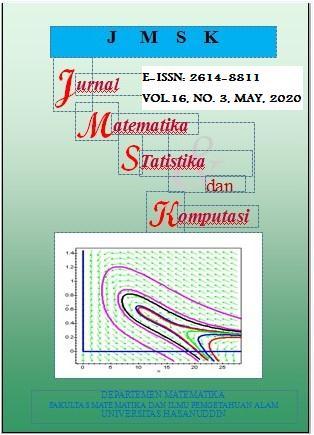Modeling Claim Frequency in Indonesia Auto Insurance Using Generalized Poisson-Lindley Linear Model
DOI:
https://doi.org/10.20956/jmsk.v16i3.9315Keywords:
Claim Frequency Modeling of Auto Insurance, Generalized Poisson-Lindley linear model, Newton Raphson Method, AIC criteria.Abstract
This paper will discuss the modeling of claim frequency from Indonesian auto insurance using the generalized Poisson-Lindley linear model. This modeling method assumes that the data of claim frequency are from populations that follow generalized Poisson-Lindley distribution. Generalized Poisson-Lindley linear model is an alternative to modeling count data that contains overdispersion. The parameters in the generalized Poisson-Lindley linear model can be estimated using the maximum likelihood estimation method through Newton Raphson's iteration numerical method. The data are the secondary data took from XYZ Company for the 2013 policy which is overdispersed. The data contains policyholder partial loss claims for comprehensive motor vehicle insurance products. From the research conducted it was concluded that the data is suitable to be modeled with generalized Poisson-Lindley linear models and produce better models than ordinary Poisson linear modeling because of produced the smaller AIC value. Of the 3 predictor variables that are modeled on the frequency of claims, 2 variables influenced they are the use variable and vehicle brand variable.
References
Akaike, H., 1974. A New Look at the Statistical Model Identification. IEEE Transactions on Automatic Control 19(6): 716-723.
Boucher, J-P., Denuit, M. & Montserrat, G., 2007. Risk Classification for Claim Counts. North American Actuarial Journal, 11(4), 110-131.
David, M & Jemna, D-V., 2015. Modeling The Frequency of Auto Insurance Claims by Means of Poisson and Negative Binomial Models. De Gruyter, 62(2), 151-168.
General Insurance Association of Indonesia. 2019. Laporan Statistik & Perkembangan Pasar Industri Asuransi Umum & Reasuransi Tahun 2018. Laporan Tahunan. Jakarta: AAUI.
Izharulhaq, H. I., Mutaqin, A. K. & Suliadi. 2016. Pemodelan Data Frekuensi Klaim Asuransi Kendaraan Bermotor di Indonesia Menggunakan Distribusi Gomez-Deniz Et. Al. Skripsi tidak dipublikasi. Bandung: Fakultas Matematika dan Ilmu Pengetahuan Alam, Universitas Islam Bandung.
Jong, P. D. & Heller, G. Z. 2008. Generalized Linear Models for Insurance Data. Newyork: Cambridge University Press.
Kementeri Keuangan. 2007. Peraturan Menteri Keuangan Nomor 74/PMK.010/2007: Tentang Penyelenggaraan Pertanggungan Asuransi pada Lini Usaha Asuransi Kendaraan Bemotor. Jakarta: Kemenkeu.
Mahmoudi, E. & Zakerzadeh, H., 2010. Generalized Poisson-Lindley Distribution. Communications in Statistics – Theory and Methods 39(10): 1785-1798.
Manfaat, B. 2016. Pengantar Teori Probabilitas. Cirebon: Eduvision.
Otoritas Jasa Keuangan. 2017. Surat Edaran Otoritas Jasa Keuangan Nomor 6/SEOJK.05/2017: Tentang Penetapan Tarif Premi atau Kontribusi pada Lini Usaha Asuransi Harta Benda dan Asuransi Kendaraan Bermotor tahun 2017. Jakarta: OJK.
Sankaran, M., 1970. The Discrete Poisson-Lindley Distribution. Biometrics 26(1): 145-149.
Shanker, R. & Fesshaye, H., 2015. On Poisson-Lindley Distribution and Its Applications to Biological Sciences. Biometrics & Biostatistics International Journal 2(4): 0036.
Sudjana. 1996. Metode Statistika. Bandung: Tarsito.
Undang-Undang Republik Indonesia. 2014. UU RI. Nomor 40 Tahun 2014: Tentang Perasuransian. Jakarta.
Wongrin, W. & Bodhisuwan, W., 2016. Generalized Poisson-Lindley linear model for Count Data. Journal of Applied Statistics 44(15): 2659-2671.
Downloads
Published
How to Cite
Issue
Section
License

This work is licensed under a Creative Commons Attribution 4.0 International License.
Jurnal Matematika, Statistika dan Komputasi is an Open Access journal, all articles are distributed under the terms of the Creative Commons Attribution License, allowing third parties to copy and redistribute the material in any medium or format, transform, and build upon the material, provided the original work is properly cited and states its license. This license allows authors and readers to use all articles, data sets, graphics and appendices in data mining applications, search engines, web sites, blogs and other platforms by providing appropriate reference.







